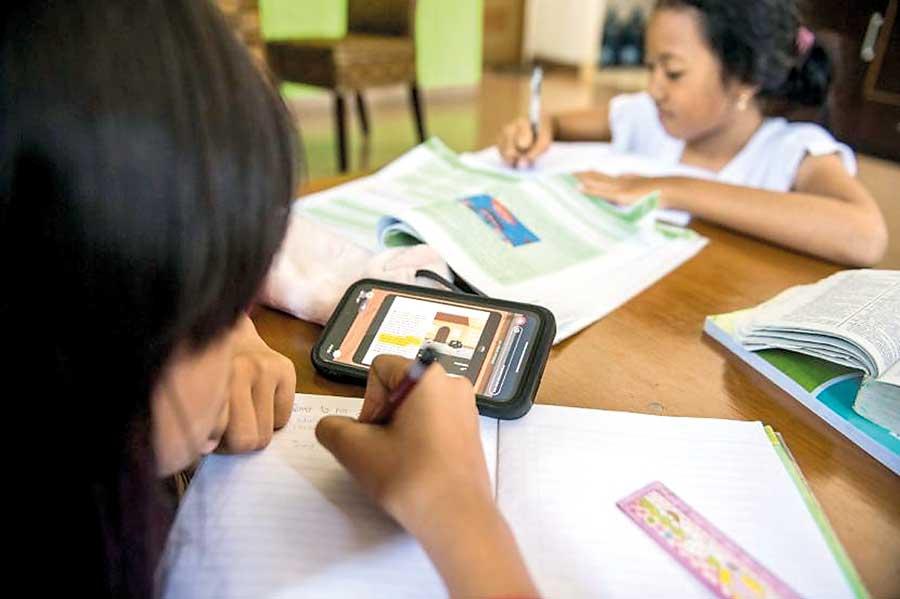27 Jan 2021 - {{hitsCtrl.values.hits}}

Children often struggle to get used to virtual learning
It was exactly a year ago that news emerged in Australia of the first COVID-19 patient. On January 25 last year, a recently returned traveller from Wuhan, China tested positive. The 365 days since have been anything, but normal.
year, a recently returned traveller from Wuhan, China tested positive. The 365 days since have been anything, but normal.
As infections went up, normal life began to unravel pretty fast. By March, the warnings were out to expect extreme measures. By June then lockdowns were effective.
When the lockdowns were at their strictest, going 5km out could potential entail identity checks resembling those that were witnessed during the height of the war in Colombo. When images of mass pool raves from Wuhan emerged, a friend here commented on social media that while those in Wuhan were partying, he was running the risk of arrest trying to get bread.
Work shifted to home and online. Even for someone like me who had been used to working from home and from the road some of the changes were drastic. The least of which, was trying to work in the same room, as two pre-teen school kids who were home-schooling on computers. It was like trying to get them to do their lessons while inside a virtual department store. They could sneak into all kinds of extracurricular activities while the lesson window was open
and running.
I lived on Zoom, Teams and other video conferencing platforms. I still do. This week I am set to be part of a workshop that will have more than 200 participants spread through Asia, simultaneous translations into five languages and different presentation formats.
Not all is dark and grey. Remote working has made spending time with those you want to hang out with easier. For some it has made the work, life balance more important than ever before. Practicing low device days is now more widespread, as are self-care and healthy leaving.
"The pandemic has taken a heavy toll on journalism. The Geneva-based Press Emblem Project estimates that since March 2020, worldwide over 700 media workers have died due to COVID-19"
But the pandemic has taken a heavy toll on journalism. The Geneva-based Press Emblem Project estimates that since March 2020, worldwide over 700 media workers have died due to COVID-19. The biggest toll has been in Peru, but India and Bangladesh rank fourth and fifth with around 100 total cases.
The monetary impact on journalism has been severe. I have been told that some Sri Lankan journalists have had their salaries cut by 60 to 70%. A recent study by the Thomson Reuters Foundation found that global ad revenue fell by 11% last year.
We have also seen how administrations intent on controlling the narrative using the pandemic and the disruption to normal life to stifle information. In Nepal, journalists found that many government officials simply stopped returning calls and putting out information as lockdowns put an end to in-person interactions.
In the Philippines, with a government already quite bullish on taking on feisty media outlets, not only did information and access to officials dry out, but human rights groups say that they have observed a spike in legal action against journalists and media outlets.
In Sri Lanka, the government is considering cyber monitoring, without divulging much details on the width and breath of such an operation.
Moreover, we have seen the mental stress on journalists rise exponentially. The combination of pressures from financial uncertainty to physical safety to that of shrinking reporting space has made self-care, especially cyber and digital self-care that much more important than
ever before.
“It’s different to you going to work on a story that’s happened to someone else, which you may or may not have experienced,” is how my colleague Dr. Cait McMahon, the Director of the Dart Centre Asia Pacific explains this.
“We are all part of the story, albeit to different degrees. That means journalists need to be more in tune with what their anxieties are, and what the anxieties are of the people they’re interviewing.”
The author is a journalism researcher and a journalist. He can be contacted on [email protected]

COVID-19 forced people to work from home
30 Nov 2024 10 minute ago
30 Nov 2024 1 hours ago
29 Nov 2024 29 Nov 2024
29 Nov 2024 29 Nov 2024
29 Nov 2024 29 Nov 2024